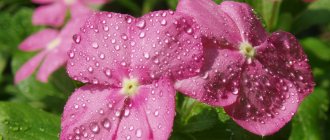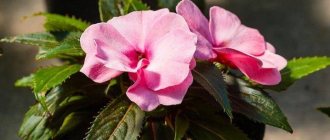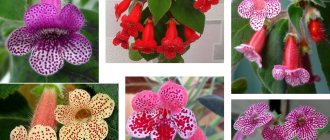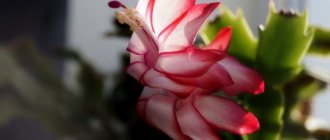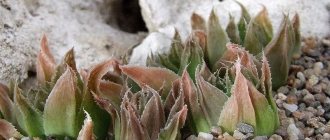Waller's balsam (Impatiens walleriana), also known as “impatiens”, is a herbaceous plant of the balsam family, with wide, alternate jagged leaves of a dark green or reddish color, about 60 cm high.
Impatiens is native to the tropical zones of Africa and Asia, since 1596 became widespread in Europe and America. Its flowers, simple or double, are arranged singly and have a bright palette of various shades, except yellow and blue. After the bud fades, the plant forms a fruit-box, which easily opens, releasing a large number of small seeds.
Impatiens is a fast-growing perennial that blooms most of the year. When propagated already in the third month after germination, balsam produces the first flowering.
Also be sure to check out how to grow apthenia at home.
| The growth rate is high. |
| Blooms from early winter to early spring. |
| The plant is easy to grow. |
| It is a perennial plant. |
Caring for balsam at home. Briefly
At home, balsam is a fairly simple and low-maintenance flower. Basic rules for keeping balsam:
| Temperature | In the summer months - no more than 21 ºС, in winter - from 10 to 16 ºС. |
| Air humidity | High humidity up to 80% is preferred. |
| Lighting | Regular abundant hydration at any time of the year. |
| Watering | The substrate must be kept moist at all times. |
| Priming | A permeable nutrient mixture of turf, humus, peat and sand with a drainage layer. |
| Feeding and fertilizer | During the growing season it requires liquid mineral fertilizers. |
| Impatiens transplant | Held annually, every spring. |
| Reproduction | Quite easily propagated by both cuttings and seedlings. |
| Features of growing balsam | Periodic pruning or pinching of shoots is required annually. It is susceptible to frequent pests and does not tolerate sudden temperature changes. |
Landing
Impatiens propagation occurs in two main ways: sowing seeds and cuttings. Each of them has its own characteristics. When propagating from cuttings, there will be no need to wait for flowering: the buds will not stop appearing even after cutting. But with the help of seed planting you can get a large number of plants, which is especially important for decorating a summer cottage or a private house.
Cuttings
The advantage of this method is that when used, the flower retains all varietal characteristics. It takes root quite easily and quickly. If the bush needs to be formed by the beginning of summer, then cuttings are carried out in the first half of March. In three months, the cuttings will have time to form roots and grow stems.
Cuttings are carried out by two main methods: water and soil.
Water rooting
The upper part of the branch, 10 cm in size, is cut off. It should have 2-3 internodes. All buds are removed so that flowering does not deprive the cutting of nutrients. The lower leaves are also removed so that they do not rot in the water.
The cut is placed in water and placed in a bright place without direct sunlight. By the end of the second week, roots will appear on it. There is no need to wait until the measles system becomes too large, as this will impair survival after planting.
After planting, you should not fertilize for the first three weeks, as this can lead to rapid growth of greenery to the detriment of the formation of buds. You should not water impatiens too often; it is better to water using the bottom method, that is, in a tray. It is advisable to use soft water, because increased hardness can make balsam sick.
Rooting in the ground
This is a fast and safe method that works 100% of the time. A healthy and thick branch is selected, from which the lower leaves are torn off. The leafless part is dug into the soil with the following composition:
- 25% peat;
- 25% vermiculite;
- 50% perlite.
Perlite and vermiculite are needed to give the soil permeability and looseness, since access to oxygen is necessary for root growth. The sprout will receive nutrients from the peat. Such soil will prevent caking and clumping of the surface, so the soil inside the pot will not be able to overheat or overcool.
The cuttings will take root only if the soil does not dry out, but constant moisture can cause rotting. To prevent this from happening, the soil must be loosened frequently, without going deeper than 1 cm. To make rooting go even faster, you can set up a greenhouse: the whole plant along with the pot is placed in a bag or covered with film, and then placed in a bright place . If everything is done correctly, then within a week the roots will appear, and the young sprout can be planted. Planting and care are carried out in the same way as with water cuttings.
Forcing from seeds
The sowing time depends on where the young plantings are planned to be kept. If the cultivation is carried out indoors, then the impatiens impatiens is sown in March, and in the case where the sprouts are planned to be kept outside, it is not worth sowing before the end of April, because the cold will destroy the seedlings. First of all, you need to navigate the weather. On average, 100 days pass from the moment of planting to the start of flowering, but there are some hybrids that begin budding earlier.
Before planting, seeds need special preparation, which will not only increase germination and reduce the time to germination, but also protect young seedlings from fungal diseases. To do this, planting material is placed in a manganese solution or laid on cotton wool soaked in this solution for a day. Immediately after removal, the seeds should be sown without drying.
Priming
Impatiens is a very demanding plant when it comes to soil. Having planted it in ordinary garden soil, you will notice that growth has abruptly stopped, and buds do not appear for a long time. Sometimes the flower dies completely.
From a purchased soil mixture, the best option would be soil for flowering plants or for ampelous surfinias, since in terms of mineral composition and looseness it is closest to what is necessary. But the ideal option would be to prepare the soil yourself. It includes the following components:
- leaf soil - 1 part;
- peat – 2 parts;
- coarse river sand – 1 part;
- vermiculite – 1 part.
If impatiens will live outside in a very hot climate, an agricultural hydrogel can be added to the soil mixture, which helps retain moisture in hot weather. 1 tsp. hydrogel for the pot will be enough, since after absorbing moisture it will increase its volume several times.
For planting, select a pot with a shallow bottom. It is better not to use a container deeper than 8 cm, since the root system of impatiens is located below the surface, so deeper layers can stagnate. It is important that the flowerpot or pot is not too spacious, as this has a negative impact on flowering, and tightness will only activate the formation of buds.
A hole must be equipped in the bottom for excess water to flow out, and drainage is placed on top of it with a 2–3 cm layer of shards or expanded clay. The container is filled to the top with soil.
The pot along with the soil must be treated with Fitosporin. To do this, the ground is watered abundantly with the prepared solution. This measure is necessary to neutralize the bacteria that cause “black leg,” to which ampelous flowers are very sensitive.
Sowing
The seeds are placed on the surface of the ground at a uniform distance of approximately 1 cm from each other. Then they are slightly pressed into the damp soil, but this is done in such a way as not to prevent light from reaching them. Sometimes, at the end of planting, the crops are sprinkled with a thin layer of sand.
It is important for seedlings to create a greenhouse microclimate. To do this, the seedlings are covered with a transparent film or glass. The container is placed in a bright and warm place with a temperature of at least 23°C, but you need to choose an area where direct sunlight does not fall on the seeds.
Caring for seedlings before germination involves periodically ventilating the greenhouse, removing drops of condensation that collect on the glass or film. During ventilation, the moisture content of the planting is checked, and if necessary, the soil is sprayed with warm water from a spray bottle.
The first seedlings should appear in three weeks, after which they will begin to quickly gain green mass.
Picking
After three true leaves appear on the plants, they need to be picked. Without this, impatiens will not form a good ampelous shape with a branched system. Plant the sprouts in separate peat pots, making sure that the main part of the plant remains above the ground, and the bare lower part goes deeper underground.
After picking, the hanging balsam still needs a greenhouse, but when it is clear that the flower has completely taken root in the new pot, the film can be finally removed. This should be done gradually over two weeks. Every day the cover must be removed for a longer time so that the sprout hardens.
Soon the impatiens shoots will begin to form bushes. If it is clear that the flower is growing only upward, it needs to be helped to branch: the top is pinched and new branches gradually appear from the side leaves, which can also be pinched after the second or third leaf.
Caring for picked young plants necessarily includes regular spraying with warm water, since balsam loves high humidity. After it forms an extensive root system, it can be transplanted to a permanent place and taken outside. Most often this happens in mid-June.
Balsam: care at home Details
Impatiens flowering
In favorable conditions, balsam flowering continues almost all year round, from early spring until December.
Its flowers, with a diameter of 4 to 6 cm, depending on the variety, can be single, with spurs, few-flowered, in the form of axillary inflorescences, and sometimes located on elongated pedicels. The rich color palette of the plant allows it to be used as a decorative decoration for rooms, balconies, and terraces. In addition, balsam is often planted on the site as a garden annual.
Before rain or after heavy watering, balsam leaves secrete transparent drops of juice, which, after drying, turn into sugary crystals. Under natural conditions, this protects the plant's pollen from ants.
Flowers of ampelous varieties of balsam look great in hanging flower pots and flowerpots.
Temperature
Homemade balsam feels most comfortable in moderately warm conditions - without drafts, hot temperatures and dry air. In the summer, it is favorable for it to be on non-sunny glazed loggias and balconies; in winter, it is better to place it in a moderately lit room with a temperature of 15-18 ºС.
Spraying
The balsam plant at home loves high humidity and it can only be ensured in hot summer conditions by regularly spraying the plant. To do this, use soft, settled water, spraying moisture onto the ground and leaves, avoiding contact with the flowers.
Lighting
This is an extremely light-loving plant, but it should be protected from the scorching sun. East windows and places with soft sunlight are perfect. In winter, additional lighting is provided for at least 14 hours a day using special lamps.
With the onset of the rest period, illumination should be reduced.
Watering balsam
Water the flower exactly as much as is required to completely moisten the soil.
If you allow the earthen ball with its root system to dry out, the balsam drops its buds and the edges of the leaves dry out. In winter, the amount of water should be reduced, but still not allowing the soil to dry out. For irrigation, softened, as well as rain or melt water heated slightly above room temperature is used.
Balsam pot
For regular abundant flowering of balsam, it is placed in a medium-sized, even slightly cramped flower pot. As a rule, this is a container with a diameter of 17 cm, which will allow the flower to direct its forces specifically to the formation of buds, and not to the development of the root system. In addition, pots that are too large cause rot on the roots due to acidification of the soil.
Priming
At home, balsam takes root well in universal soil, but slightly acidic soil of the following composition is also used:
- turf land (1 part)
- sand or perlite (1 part)
- leaf soil (3 parts)
Regardless of the type of soil, a drainage layer consisting of charcoal or expanded clay is required.
Feeding and fertilizer
Impatiens will benefit from liquid phosphorus-potassium mineral fertilizers, which will support the plant during the growing season and ensure lush growth and flowering. These products are fed once every 10 days, through watering or spraying. Impatiens does not tolerate organic additives.
Also, you should not fertilize the flower during the dormant period or during illness.
Transfer
Balsam is transplanted annually in spring into small containers of regular size.
More often, the transfer method is used, in which the flower bush is carefully removed from the pot without shaking off the soil at the roots, then placed in a new container, followed by filling the resulting voids with new soil. The root collar of the plant is not covered with soil. After watering, the newly planted balsam is placed in the shade and taken out to its usual place only after three days.
During the flowering period, balsam cannot be replanted, otherwise it will shed existing buds and stop growing.
How to prune balsam?
Caring for balsam at home also involves pruning the shoots of the plant, which is carried out simultaneously with replanting. This is necessary not only to form a neat spherical shape, but also to rejuvenate the plant, stimulating its growth and flowering.
In addition to pruning, bare elongated shoots are regularly pinched, leaving 3 buds on the branch. Cuttings can be placed in water for rooting.
Rest period
The rest period for balsam is often forced. In sunny regions with a mild climate, the plant can bloom all year round. And in cold areas, the flower goes to a shaded place for the winter from October or December to February.
Conditions during this period: air temperature not higher than 15-18 ºС, moderate watering, excluding fertilizing and spraying.
Description
The shoots of ampelous impatiens can reach 50 cm. They actively branch and give the plant a spherical shape. When the humidity level is high, droplets of water appear on the leaves, which is why the flower is also called “Wet Vanka”. Some varieties have burgundy leaves, while others have dark green leaves with jagged edges. It blooms profusely all summer, after flowering seed pods appear.
Among the varieties you can find different flower colors
Thanks to active selection, many varieties have been developed. Each of them has its own characteristics. For example, velvety species have rosette-shaped inflorescences. The traditional flower shape is a five-petaled bell. Some varieties have double colors, which makes the plant even more beautiful.
Popular types:
- Deep Orange - bright orange flowers, dark green foliage.
- Burgundy - inflorescences of a rich crimson hue.
- Salmon - salmon-colored flowers with a red center.
- Red Star - white inflorescences with a cherry border.
Important! It is not difficult to care for impatiens; it is important to observe the temperature regime and water the plant in a timely manner.
Growing balsam from seeds
One of the features of this flower is the ripening of the capsule fruit, which cracks upon any contact from the outside, releasing many seeds that remain viable for up to 8 years. The soil for sowing must be sifted and disinfected. This can be either just a peat-sand mixture, or a substrate of garden soil mixed with sand. Usually sowing is carried out in April-May, but some varieties of balsam, for example, New Guinea hybrid, can be sown as early as January.
Technique for sowing balsam seeds:
- the prepared substrate is laid out in small containers and moistened with a spray bottle;
- the seeds are laid out on the surface of the ground so that the distance between them is about 3-4 cm;
- It is not recommended to sprinkle the seeds completely, only lightly with sand or sifted soil;
- After moistening the crops, greenhouse conditions are created.
After 5-15 days you can expect the plant to sprout. When they reach a size of 1 cm, having a pair of full leaves, this is an indicator that it is time to dive.
In order to admire the flowering of young balsam in the summer, it is worth sowing seedlings in early March.
Agrotechnics of cultivation
Given its tropical origin, impatiens can be grown as a potted crop or in open ground. In the latter case, this is possible only in the summer. When the temperature drops below 13°C, the plants die. For this reason, balsams live as garden crops only for one season. However, if you dig up a bush at the beginning of autumn and plant it in a pot, it will quite survive until the next season in the house. In the spring it will be possible to take cuttings from impatiens and get young specimens.
It is worth considering that balsams are demanding on soil and do not grow well in heavy garden soil. The substrate should be light; it is ideal to use a purchased soil mixture for hanging surfinias. You can also prepare loose and nutritious soil yourself. To do this, you will need 1 part vermiculite, leaf soil, river sand (coarse) and 2 parts peat.
If impatiens will grow in a pot, it is better to give preference to shallow bowls, given the shallow root system.
Caring for ampelous balsam is no different from growing its other species. In summer, the bushes need to be watered frequently, otherwise they will wither. Twice a month it would be a good idea to feed them with potassium-phosphorus fertilizers. Then the flowering will be even more magnificent.
Propagation of balsam by cuttings
The easiest and fastest way to propagate balsam is by plant cuttings. For this purpose, in May-June, strong, healthy flower specimens are briefly placed in the shade. As soon as the bush produces several elongated shoots, they are cut off and rooted in water.
Then they are planted in separate containers with a slightly acidic soil mixture. Thus, the flower can be propagated at any time of the year. A plant grown in summer blooms even in winter.
It is worth remembering that young plants need bright lighting, otherwise the sprouts will stretch out greatly without gaining strength and color.
How to care?
When three leaves appear on the seedlings, you will need to pick the seedlings. They can be replanted in peat or plastic cups. Balsam is very moisture-loving, but it should not be overwatered, as this will damage its roots. If the seedlings have grown elongated, they should simply be placed deeper into the ground when picking. After this, the plant still needs greenhouse conditions, so you should not immediately remove the film from the pots; you need to gradually tame the seedlings, sometimes opening the glass or film for a while.
Young balsam shoots soon begin to create mini bushes; if this does not happen, then you need to pinch the tops with them; the more side shoots that come from it, the bushier the plant will be.
After picking, seedlings must be sprayed regularly, especially in hot weather. Once the plant has formed strong roots, it can be planted in open ground or in pots. The right time for this is mid-June.
Video shows how to grow from seeds:
Diseases and pests
In winter, the plant is susceptible to fungal diseases, and gray rot attacks it especially often. It can be eliminated using the following method: clean the roots of the plant from the old soil, replant it in new soil and a pot.
When there is little humidity in the room where balsam grows, spider mites annoy it. The first sign of its settlement on a plant is curled leaves that begin to fall off on their own. Medicines in the form of Karate, Dimitam and Actellik will help you cope with the tick.
The presence of whitefly on balsam bushes is indicated by yellowing leaves. It usually settles on the inside of the lower leaves. You can get rid of it by using special means: Decis, Fufanon and others.
Growing balsam from seeds is not easy, but if you follow all the recommendations, you can eventually get healthy and long-flowering bushes. They will decorate any garden, house and balcony. The decorative effect of the plant is established even during the growth of the seedlings, to enhance it it is worth periodically spraying the plant with “Zircon” or “Kornevin”.
Diseases and pests
When keeping balsam, gardeners often encounter the following problems:
- Balsam leaves wither and fall off. Occurs at temperatures below 10 ºС, as well as when there is a lack of moisture.
- The stems are stretched. The reason is an acute lack of bright lighting.
- The appearance of spots on the leaves. Caused by fungal diseases of the flower.
- The balsam buds are falling. This occurs at too high temperatures, in hot air, and also when the soil dries out.
- Leaves curl and fall off. Lack of minerals, too high soil moisture.
- The leaves become pale. This problem is caused by staying in the shade for a long time, or the appearance of parasitic insects.
- Impatiens does not bloom or blooms poorly. It occurs due to a lack of nutrients or the use of nitrogenous fertilizing, which causes abundant development of foliage.
Balsam pests include spider mites, false scale insects, thrips, and aphids and whiteflies are also common.
Possible problems
If Waller's balsam is not cared for correctly, the following problems may arise with it:
- The foliage begins to wither and flies away . This is due to too little and infrequent watering or the room is very cold (below 10 degrees).
- Pulling out shoots . Excessively poor lighting.
- Spots form on the foliage . The bush is affected by a fungal disease.
- Flying around the buds . The room is too warm or the earthen ball in the pot has dried out.
- The leaf blades curl and fly around . The substrate regularly stagnates in moisture or the plant suffers from a deficiency of minerals.
- The color of the foliage becomes faded . This is due to the bush staying in a shaded place for a long time or pests have settled on it.
- Flowering is scanty or absent . Most often this occurs due to lack of nutrients. Or a large amount of nitrogen is introduced into the substrate, which activates leaf growth to the detriment of flowering.
- Pests . Most often, whiteflies and aphids settle on the flower. The bush can also be attacked by false scale insects, spider mites and thrips.
Types and varieties of homemade balsam with photos and names
Waller's balsam, or Waller's impatiens, or Waller's impatiens, "impatiens", "Roly-wet", "light", "water fuchsia", (Impatiens hostii, Impatiens walleriana, Impatiens sultanii) - all these are the names of one plant species, which is the source of a numerous series of hybrids. This type is characterized by long and abundant flowering, axillary inflorescences with five petals, finely toothed leaves 12 cm long.
Popular varieties and groups of Waller's balsam
Balsam Series 'Accent F1'. Miniature plants 15-20 cm high, with large flowers of a wide variety of colors.
Balsam Series 'Tempo F1 Hybrid'. The length of the plant's stem ranges from 20 to 25 cm. It is characterized by early vegetation with orange and pink flowers.
Balsam Series 'Stardust F, Mixed'. It has richly colored inflorescences with petals edged in deep red, pink or coral.
Balsam Series 'Bruno F1'. The very first series of flowers with a doubled set of chromosomes. The variety is characterized by high resistance to temperature changes, larger flowers with a diameter of 6 cm, and early seed germination.
Balsam Series 'Firefly'. The plant is a neat, abundantly flowering bush with flowers of purple, scarlet, and peach shades, hiding greenery behind it.
Balsam Series 'Fiesta F1'. It is distinguished by a more branched structure, as well as double one-color or two-color rosette flowers.
New Guinea balsam is a hybrid of Impatiens balsam with a stem height of 30 cm and single flowers with a diameter of 7-8 cm and having spurs.
Popular varieties of New Guinea balsam
Balsam series 'Java'. It has inflorescences of bright “tropical” color framed by rich green foliage.
Balsam series 'Jangle Rain'. Produces flowers in delicate pastel colors.
Balsam series 'Rainforest Exotic'. Bicolor variety with dark green foliage.
Varieties
On sale you can find different varieties that differ in the color of the leaves, the type and color of the inflorescences, and the length of the stems. There are drooping forms that hang from the lawn, and there are those that form a dense and tall ball over a hanging planter.
At the moment, two varieties of hanging balsam are considered the most beautiful and stable: “Highlight” and “Acrobat”. Both of them are hybrids, so it will not be possible to reproduce them from the seeds of an existing impatiens: the daughter plant will not show all the signs.
“Highlight” is represented by the following varieties:
- "Burgundy";
- "Coral";
- "Red Star";
- "Salmon";
- "Deep Orange"
The “Acrobat” variety has the following hybrids:
- "Rose";
- "White";
- "Purple Star"
When choosing planting material, you need to pay attention to these hybrids, since they were bred by breeders for hanging cultivation.
Burgundy
Coral
Red Star
Salmon
Deep Orange
Rose
White
Purple star
How and when to plant?
As when planting Primrose, for home decoration, ampelous balsam is planted in early March, and if the flower is located outside, then the seeds are planted at the end of April.
Before planting in the ground, the seed must be prepared; it is placed in a weak solution prepared from potassium permanganate and water. The seeds are kept in it for 24 hours.
While the seeds are being prepared, the soil required for them should be prepared. Impatiens are very sensitive to the composition of the soil; the soil must be well drained and have a slightly acidic environment.
The best option would be to mix it yourself, using:
- 1 part leaf soil;
- 2 parts peat;
- 1 part river sand (coarse-grained);
- 1 part vermiculite.
The last two components make the soil breathable and loose; they allow the soil to dry out in time so that the roots of weak seedlings do not die from excess moisture.
The container for sowing seeds should not be deep; it is enough if it is 8 cm in height. Through holes must be made at the bottom of the selected pot or container, and then a layer of expanded clay, at least 2 cm thick, must be poured into it. Then the container is filled up to the sides soil and watered with a solution of “Fitosporin”, which can prevent the appearance of a disease such as “black leg” on the shoots. You can use a well for irrigation in your dacha.
It will also be interesting to learn how to grow Balsam from seeds at home.
Video on how to grow flowers:
The seeds are placed on the surface of the prepared pot with an even distance from each other, this will ensure uniform germination of the plant. The seeds are lightly pressed, but not completely immersed in the ground, so that they can receive enough light to germinate. Sometimes they are covered with a small layer of sand, but this is not necessary.
After planting the seeds in a pot, it is transferred to a warm and bright place, preferably on a windowsill, but the seedlings must be protected from direct sunlight. But you can learn how to plant a willow from a twig into a pot from this video.
To germinate balsam, you need to create a greenhouse effect; you can cover the container with the seeds with film or place glass on it, then periodically open it and shake off the condensation that collects from it. If you need to moisten the soil with a spray bottle. Sprouts will appear three weeks after planting; if this does not happen, you will have to sow the container with other seeds.
You can find out how Bacopa ampelae is grown from seeds by watching the video.
It will also be interesting to learn about how Tithonia is planted and cared for.For those who want to learn more about how to grow Amaranth from seeds, you should follow this link: https://2gazon.ru/ozelenenie/cvety/palisadnik/amarant-vyrashhivanie-iz-semyan-kogda-sazhat.html
Maybe
